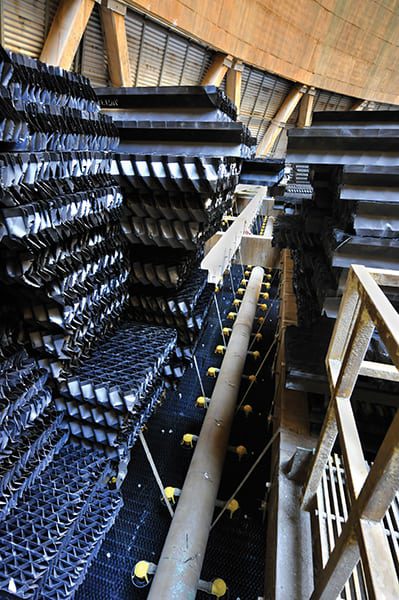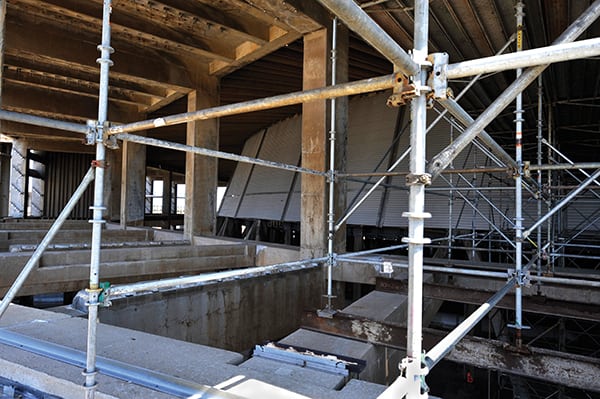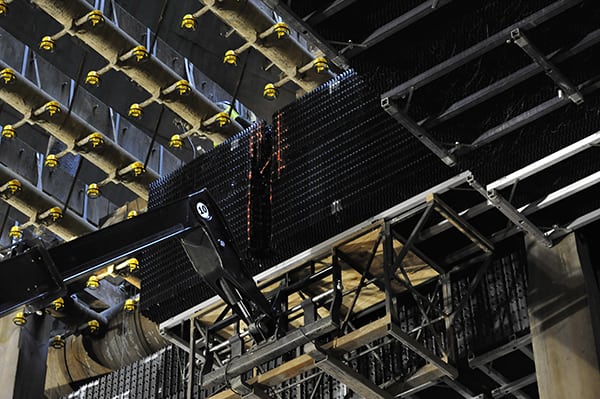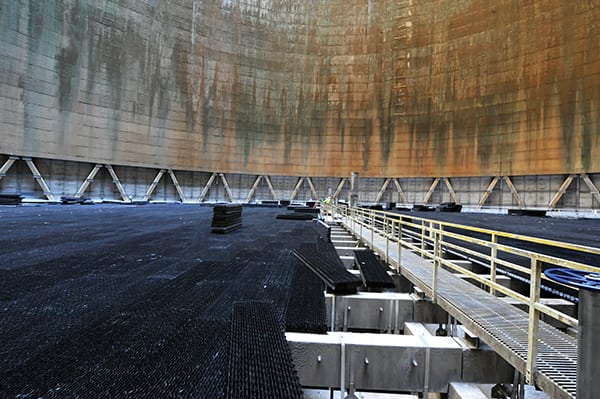Smart Access Planning Enables Efficient Cooling Tower Maintenance
Two hyperbolic cooling towers rise 495 feet over Exelon Corp.’s Byron Generating Station about 110 miles west of Chicago, Ill. The towers help cool the two Westinghouse pressurized water reactors that are capable of generating up to 2,346 MW at the site.
Like all classic wet transfer hyperbolic cooling towers (Figure 1), the Byron Generating Station uses fill packs to increase the exposed surface area of the water, as well as to increase the air-to-water contact time. These actions increase the rate of heat transfer and the amount of heat transfer, respectively. In a film-type fill pack, water flows in a thin film over stacks of vertically oriented plastic sheets spaced about 0.75 inch apart. The sheets feature a corrugated or V-shaped pattern to further increase surface area and contact time.
An Upgrade Is Warranted
Recent film-fill developments have created low-clog, open, angular cross-corrugations that allow debris and biological growth to pass through. However, this design did not exist when the towers at Byron were built. Over the years, the station’s fill packs developed excess biological growth and accumulated silt. As a result, the fill packs bulked up from less than 100 pounds to more than five times their original weight.
Normally, fill packs hang 30 to 35 feet above the cold-water basin (Figure 2). However, they are designed to break away and fall from their attachments when they get too heavy, a feature that prevents damage to the tower structure.
When several of the fill packs attached to the cooling towers of the Byron Generating Station became over-burdened and fell into the cold water basin, Exelon engineers decided to replace all of the fill packs in both towers. They also decided to replace the drift eliminators, honeycomb-like PVC components (Figure 3) that hang above the water distribution system to capture and limit the quantity of water droplets contained in the air stream leaving the cooling tower. In all, more than 5,000 components would need replacement.

|
| 3. Puzzling pieces. In addition to changing fill packs, drift eliminators, stacked here on beams above the water distribution nozzles, were also replaced. Courtesy: David Joel Photography |
To perform the maintenance, Exelon consulted SPX Cooling Technologies Inc., its cooling tower manufacturer. The work had to be done within two three-week windows, six months apart, while the reactors were shut down for routine scheduled refueling. Planning was critical. Surprises, delays, or complications would affect Exelon’s ability to deliver electricity to northern Illinois.
Working Quickly and Safely
SPX’s first challenge was getting access to the fill packs in a way that would allow its staff to work quickly and safely. As noted, the fill packs are above the cooling basin, which holds 8.5 feet of water. The drift eliminators are above the fill packs, with components for the water distribution located between them. The basin itself also contains a network of pipes for water circulation. During operation, water falls inside the cooling tower at a rate nearly that of a thunderstorm. In short, gaining access to the fill packs and drift eliminators required extensive planning, extreme efficiency, and attention to safety.
SPX has a longstanding relationship with Safway Services, an access and industrial services company based in Waukesha, Wis. Safway specializes in complex industrial environments where planning, efficiency, and safety are all critical to success.
“We know Safway has the right equipment, and we know they have the design (engineering) services we need for an environment like this,” said Duane Krehbiel, director of MCT Services Construction at SPX and project manager for the Exelon job. “With a job like this there’s a lot of work up front, and we know Safway will do it right.”
The Right Stuff
The “right equipment” Krehbiel mentioned is Safway’s Systems Scaffold, which is engineered to provide fast and easy erection. To assemble it, workers hook horizontal or diagonal members (galvanized steel tubing) to rings on the vertical posts. Using a hammer, they drive home a wedge until a retainer pin drops and locks the member in place.
To disassemble, workers lift the retainer pin with a Safway pry-bar hammer and loosen the wedge with a quick flick of the hammer. The design allows for 360-degree placement around the vertical post rings, and rings are spaced every 21 inches on vertical posts for easy height adjustment (Figure 4). Special component jacks, support frames, braces, and varying lengths of the horizontal members enable the scaffold to conform to sloping surfaces (such as on a boiler cavity), and all components can be passed through small openings.

|
| 4. Versatile construction. Post rings on Safway’s Systems Scaffold allow quick assembly and offer a variety of orientation options to meet diverse project needs. Courtesy: David Joel Photography |
“Cooling towers present complex access situations, and working within the time constraints of a refueling shutdown demands speed. Systems Scaffold excels in this type of environment because of its adaptability,” noted Jim Waichunas, Safway Tracking System coordinator for Safway’s Eastern Division and SPX’s liaison for the project.
To monitor every aspect of the Exelon project, Waichunas used the Safway Tracking System, a proprietary software program that manages all of the resources for a project.
“The Safway Tracking System provides a clear picture of costs and bottlenecks and helps us to stay on top of other key performance indicators in real time,” said Waichunas.
Planning Leads to Success
With an outage of three weeks, Safway wanted to give SPX workers as much time as possible to perform their task. The plan involved building four sections of scaffold that would start on the outer ring of the tower and work toward the inside of the parabolic curve. When completed, each section of scaffold would measure about 21 feet wide, 90 feet long, and 45 feet high so the SPX crew could reach the drift eliminators. After the SPX crew finished work on one section, the Safway team would dismantle the scaffold and move it laterally to reach a new area (picture clock hands sweeping around the dial).
“The eight-and-a-half-feet of water in the cold water basin and the constant ‘rainstorm’ inside the parabolic curve presented the biggest challenges to scheduling,” said Waichunas. “Exelon couldn’t drain the basin or stop the cooling water spray until the outage began.”
Two weeks prior to the scheduled outage, Exelon brought in divers. Directed by the Safway team, the divers erected the Systems Scaffold base (standard screw jacks and wood blocking) and one level of scaffolding underwater.
“It required good planning because there was a pretty strong current moving through the water,” Waichunas recalled.
With the base in place, the Safway crew erected as much scaffold as they could in the outer ring of the cooling tower, working up to the edge of the rainstorm. Once the reactor outage began, the Safway team quickly built the scaffold up to full height and the SPX personnel took over.
Krehbiel said SPX and Safway had worked out a “Plan B” to allow work in wet areas with a partial shutdown of the spray system if the job went longer than three weeks. As it turned out, they didn’t need it. With demonstrated success, the Safway and SPX teams completed work on the second tower about six months later using a similar schedule.
In both cases the SPX team accomplished its mission in the allotted three weeks with no major incidents (Figure 5). Once the maintenance was complete, the Safway crew finished removing the scaffolding—about a two-week job.
“The take-down was actually done in phases, because our crew dismantled sections of scaffolding where the replacement of materials was finished,” Waichunas, said. “Systems Scaffold is also simple to take down, which makes things more efficient.” ■
—Edited by Aaron Larson, a POWER associate editor.


